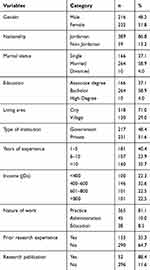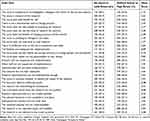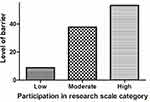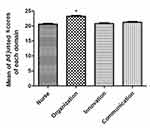Back to Journals » Risk Management and Healthcare Policy » Volume 13
Jordanian National Study of Nurses’ Barriers and Predictors for Research Utilization in Clinical Settings
Authors Abuhammad S , Alzoubi K , Khabour O , Mukattash T
Received 31 August 2020
Accepted for publication 8 October 2020
Published 12 November 2020 Volume 2020:13 Pages 2563—2569
DOI https://doi.org/10.2147/RMHP.S279043
Checked for plagiarism Yes
Review by Single anonymous peer review
Peer reviewer comments 3
Editor who approved publication: Professor Marco Carotenuto
Sawsan Abuhammad,1 Karem Alzoubi,2 Omar Khabour,3 Tareq Mukattash2
1Department of Maternal and Child Health, Jordan University of Science and Technology, Irbid 22110, Jordan; 2Department of Clinical Pharmacy, Jordan University of Science and Technology, Irbid 22110, Jordan; 3Department of Medical Laboratory Sciences, Jordan University of Science and Technology, Irbid 22110, Jordan
Correspondence: Sawsan Abuhammad Email [email protected]
Background: The nurses are the healthcare providers and researchers in the health institutions. Investment in the research potential of nurses will ultimately benefit society. The purpose of this study was to survey nurses regarding barriers to participating in research studies.
Methods: This was a cross-sectional descriptive study using electronic surveys sent by email, and social media groups (WhatsApp). A total of 447 nurses agreed to participate in this study. Barriers were measured using the Barriers of Research Utilization (BRU) Scale.
Results: More than half (53.3%) of the participants perceived the barriers to be high, whereas a small fraction (8.9%) perceived them as low. Barriers related to the organization scored the highest (P< 0.01) compared to the other domains (nurse, innovation, and communication). The regression analysis model showed that age, working experience, and nationality were associated with barriers to participate in research (P< 0.05).
Conclusion: More than half of the nurses in Jordan perceived barriers to participating in research studies to be high. The barriers associated with the organization had more influence. A comprehensive approach should be developed to boost research utilization among nurses by overcoming the barriers identified in the current study.
Keywords: barriers, nurses, research, clinical settings, research utilization
Background
All professions and specialties require scientific research. The researchers use the gained knowledge to improve the state of science in all fields1 and to benefit both the researchers and society. The nurses are healthcare providers and researchers in the health institutions that provided health care for people. Investment in the research potential of nurses will ultimately benefit society.2–4 Therefore, the decision makers and institutions need to know the barriers that are preventing nurses from participating in research.
Many studies have reported that the main barriers toward research utilization are related to the organization. This includes inappropriate support from professionals, culture and climate of the work.3,5 Other factors include the nurses’ characteristics related to poor knowledge and skill, negative attitude toward nurses, and poor awareness of the importance of evidence-based practices.3,6
In Jordan, there is a demand to increase the quality of healthcare and to reduce its cost. This is especially essential because of the limited resources, coupled with an increasing number of well-educated patients who demand high standards from the health care system. Besides, the health care system in Jordan is experiencing cost and quality challenges that nursing research can address.2,4,6 Several studies were conducted in other countries to examine the barriers of research utilization among nurses7 and how such barriers are influenced by demographic variables.3,8 Assessment of research utilization among nurses insures that individual, environmental and organizational characteristics are the main predictors of research utilization in clinical settings. Studies found that organizational factors are more important determinants of research utilization among nurses than other predictors. To the extent of our knowledge, no previous study has been conducted to identify barriers and factors associated with utilization of research in clinical settings among nurses in Jordan. Identifying such barriers may help decision makers and institutions to engage more nurses in the research to enhance the visibility of nurses in developing evidence-based health care. Therefore, the purpose of this study was to survey nurses in Jordan regarding barriers of research utilization.
Methods
Research Design, Sample, and Setting
A descriptive cross-sectional correlational design was used to fulfill the goals of this study. A survey questionnaire was distributed electronically to a convenience sample of 1,000 nurses working in private and governmental hospitals in Jordan. Researchers used the G*Power software version 3.1.92 to calculate the required sample size. A significance level of 0.05, a power of 0.95, and 11th variables were used with a medium effect size of 0.15 resulting in a minimum number of subjects being 420. However, since using electronic surveys have a low rate response, the researcher sent 1,000 surveys. A total of 448 nurses agreed to participate in the study with a response rate of 45%.
Procedure
A convenience sample of nurses who met the requirements for inclusion in the research was invited to participate. Access to the nurses’ contact was facilitated via the head of each ward. The investigators approached each eligible nurse to give them a summary of the study and then asked them if they would like to take part in the study. The inclusion criteria were nurses from both genders that worked in both private and public clinical settings in Jordan and were able to write and speak in the English language. Exclusion criteria were those nurses who were working overtime or were agency nurses since they are not allowed to participate in such research activities. If the nurses agreed to participate, their informed consent was obtained at this time. The electronic questionnaire was then sent to those who consented to participate in the study via e-mail or WhatsApp. Out of a total of 1,000 surveys that were distributed, 448 were filled in electronically. Data was collected from May to July 2020.
The electronic survey consisted of two parts. The first part asked about age, gender, marital status, income, years of experience, nursing rank, nationality, living arrangements, and working areas. Two other questions were asked about previous publications and participation in research. The second part was about the Barrier of Research Utilization (BRU) scale. The scale was developed by Funk et al,9 and includes 28 items. Each item is rated from 1 (“to no extent”) to 4 (“to a great extent”) reflecting the degree to which the item is perceived as a barrier. Four subscales are utilized in this scale that includes: 1) characteristics of the nurse such as the nurse’s own awareness (8 items); 2) characteristics of the organization (8 items); 3) characteristics of the innovation (6 items); and 4) characteristics of the communication with their organization (6 items). The scores of this scale range between 28 and 112. Scores from 28 to 56 are considered low, scores from 57 to 74 are considered moderate, and scores 75 to 112 are considered high. This scale has been verified for validity and reliability among nurses.7,9 Cronbach’s α‐value was 0.86.3 The reliability of instrument for the current study was 0.88. Content validity of the instrument was supported by the literature on research utilization and data gathered from nurses. Input was also gained from experts in the field of research utilization, nursing research, nursing practice and a psychometrician to establish face validity (ie, whether the tool appears to measure the concept intended and content validity from an extensive list of potential items).
Ethical Consideration
The IRB Committee of Jordan University of Science and Technology approved the protocol of this study. No information that could identify the participant were requested. The information in the consent form stated that the researchers will use the information to help nurses and people in the community. The researchers will maintain the privacy of the nurses’ information; the researchers will not use any information in presentations or publications in a way that could identify the participants.
Statistical Analysis
Data were analyzed using SPSS statistical software version 25. Descriptive analysis was used for the demographic variables of the participant and a multiple regression test was used to determine the correlation between the variables and research utilization. A P-value <0.05 was considered significant.
Results
Descriptive Analysis
Demographic characteristics of the study participants are shown in Table 1. Average age of participants was 35.3 (SD= 8.2) years, and females were 51.2%. The majority of the study participants were Jordanian, married, and living in a city. They worked in both governmental and private institutions with years of work experience ranging from 1 to over 10 years. Most of the study participants (81.1%) were practicing nurses. Yet, only 35.6% had previous research experience, and 11.6% had research publications.
 |
Table 1 Demographic and Work Characteristics of Study Participants (n=448) |
Perception of Barriers to Research Utilization
Perception of barriers to research utilization was measured using the BRU scale. According to the scale, 53.3% of the sample perceived the barriers to be high, whereas 8.9% perceived them as low (Figure 1). In addition, slightly more than one-third (37.8%) perceived the barriers as moderate. When the items of the BRU were divided according to the four domains of the scale, barriers related to the organization domain scored the highest compared to the other domains (nurse, innovation and communication, P<0.01; Figure 2). According to the individual items of the scale (Table 2), the highest mean scores were for the following: “The nurse does not feel she/he has enough authority to change patient care procedures” (3.13) and “The facilities are inadequate for implementation” (3.07). On the other hand, the lowest mean scores were for the following items: “The research is not relevant to the nurse’s practice” (2.34), “The conclusions drawn from the research are not justified” (2.42), and “The literature reports conflicting results” (2.46). Table 2 shows the responses to the items of the scale.
 |
Table 2 Response of Barriers of Participation in Research |
 |
Figure 1 Perception of barriers to participation in research according to the BRU scale. Values were expressed as percentages. The total sample numbered 448. |
Multiple Regression Analysis
Multiple regressions were used to predict nurses’ perceptions of barriers to research utilization according to demographic variables (age, gender, education level, work experience, and job role). Table 3 summarizes the outcomes of the multiple logistic regression model. All of the listed factors were not associated with the perception of barriers of research utilization (P-value > 0.05) except age, and working experience (P-value < 0.05).
 |
Table 3 Multiple Regressions for Barriers of Research Utilization (n=448) |
Discussion
This is the first study to examine the barriers of participating in research among nurses working in both private and governmental hospitals in Jordan. The study showed that the perception of barriers to research utilization among Jordanian nurses is high. In addition, barriers related to the organization scored the highest compared to nurse, innovation and communication domains. This result is in agreement with other previous studies. For example, it was found that perception of research utilization for nurses in Bahrain is high and related to issues of organization and authority.10
The current study found that the main barrier of research utilization according to nurses’ perception was the failure of nurses to consider themselves capable of changing the procedure of caring for patients. This outcome agrees with various studies such as Buhaid et al in Bahrain.10 Thayumanavan and Paul in Bangalore11 and Nwozichi and Ojewole in Nigeria12 who reported similar results regarding authority and organizational issues. In general, medical institutions have an environment that shows medical dominance, where doctors impose most clinical decisions on other medical staff including nurses. This usually leads to a negative impact on the self-confidence of nurses and reduces their authority and power within the confines of their career.13,14 Nurses require official authorities that enable them to create the best working atmosphere, including utilizing research, not only for their advantage but also for the patients’ benefits by offering high standards for patients.15,16 Previous studies indicate that many nurses assume that they do not have the power to make a difference in their workplace.8,11
The current study found that the second barrier of research utilization was “inadequate research implementation facilities.” This was in agreement with previous studies that reported the important role of the organization in promoting participation in research among nurses.16–18 Thus, healthcare organizations should make sure that resources are given to achieve greater levels of participation in research among nurses and the application of the research findings in the work environment.19,20 Nurses may require logistic assistance and motivation for the adoption of research to promote access to research utilization resources. However, Jordan is among the developing nations with limited resources that may influence the application of research outcomes.3 Thus, appropriate management of the available resources in the organization is one method that can assist nurses in applying research in their job.
The multiple regression analysis was used to comprehend the effect of the demographic attributes of nurses on their views regarding barriers to research utilization scale. Current findings and previous literature have indicated that there was no substantial connection between the nurses attributes and the perception towards the obstacles to involvement in research.18,21,22 For example, previous studies showed that none of the individual and career attributes including age, sex, experience, education research, and involvement, had a significance impact on participation in research among nurses.3,5 In fact, research on barriers to research utilization indicated that nurses perceive organizational factors as barriers more than their attributes.5,23
Studies showed a positive association between the duration of experience and the recognized barriers.18,24 According to the current study, experience had a negative correlation with barriers to participation in research. This may be because nurses with more years of experience often have higher administrative power in hospitals, which probably allow them to execute research outcomes in a clinical environment that could ultimately reduce their view towards research utilization barriers. More experience years give nurses the perception of having the professional power to alter practice.
From the outcome of the current study, it appears that nurses with younger ages show more positive attitudes toward research. This may be related to the fact that nurses who are younger still have updated information about methods of research, statistics, and evidence-based practice.25–27 Establishing research and education units in hospitals may be useful in which nursing research is investigated for its clinical environment use; such research and education units could additionally offer consultation to nurses and help concerning methods of research and statistics. There is a high recommendation that nurses’ management be very proactive in applying research outcomes into practice and in providing support to nurse researchers.
Relevance to Clinical Practice
There must be an explicit adoption of research utilization policy in clinical institutions. Recognizing the perceived barriers to the utilization of research would promote applying up-to-date research outcomes that may increase the standard of patient care, with little conflict in roles and more self-esteem among certified nurses. Besides, evidence-based practice could reduce the cost of health care, the length of hospital stay of patients, and possible complications in their health.
Limitations
This study used a cross-sectional design which limits its findings in respect of any cause-effect relationship. However, the main limitation of this study is the use of a convenience sample. The major criticism of convenience sampling is bias, and that the sample may not be representative of the entire population. Another disadvantage in using a convenience sample is the inability to generalize and make inferences about the entire population based on the obtained results. Moreover, the response rate was low which may limit the generalization of the results to other countries.
Conclusions
There has not been a wide implementation of research utilization among nurses in Jordan due to several barriers. The barriers associated with the organization had most influence. Therefore, a comprehensive approach should be developed to boost research utilization among nurses by significantly improving managerial support since it was the most predictive facilitator. Specific emphasis should be given to research-oriented continuing education programs, especially for the newly selected nursing cadre.
Abbreviation
BRU, Research Utilization Scale.
Data Sharing Statement
The datasets used and/or analyzed during the current study are available from the corresponding author on reasonable request.
Ethics Approval and Consent to Participate
This research obtained approval from Jordan University of Science and Technology IRB (#20,202,343). A consent form was signed by all the participants.
Acknowledgment
Perception of Barrier of Research utilization (BRU): this scale was developed by Funk et al.9
Author Contributions
All authors contributed to data analysis, drafting or revising the article, have agreed on the journal to which the article will be submitted, gave final approval of the version to be published, and agree to be accountable for all aspects of the work. All authors have read and approved the manuscript and ensure that this is the case. Consent to publish: We gave the right to publish.
Funding
This project was carried out as part of “The Research Ethics Education Program in Jordan” and has been supported by NIH grant number (1R25TW010026-01). The funder support data collection and fees for publication.
Disclosure
The authors report no conflicts of interest in this work.
References
1. Hendricks J, Cope V. Research is not a ‘scary’word: registered nurses and the barriers to research utilisation. Nordic J Nursing Research. 2017;37(1):44–50. doi:10.1177/2057158516679581
2. Cidoncha-Moreno MÁ. Barriers to the implementation of research perceived by nurses from Osakidetza. Enfermería Clínica. 2017;27(5):286–293. doi:10.1016/j.enfcle.2017.03.011
3. Hweidi IM, Tawalbeh LI, Al-hassan MA, Alayadeh RM, Al-Smadi AM. Research use of nurses working in the critical care units: barriers and facilitators. DimensCrit Care Nurs. 2017;36(4):226–233. doi:10.1097/DCC.0000000000000255
4. Mohamed NA, Mohamed HA, Mohamed SH. Evidence-based practice: barriers and facilitators among Nurses. Zagazig Nursing J. 2015;11(1):174–191. doi:10.12816/0029264
5. Aljezawi M, Al Qadire M, Alhajjy MH, et al. Barriers to integrating research into clinical nursing practice. J Nurs Care Qual. 2019;34(3):E7–11. doi:10.1097/NCQ.0000000000000371
6. Al Khalaileh M, Al Qadire M, Musa AS, Al-Khawaldeh OA, Al Qudah H, Alhabahbeh A. Closing the gap between research evidence and clinical practice: Jordanian nurses’ perceived barriers to research utilisation. J Education Practice. 2016;7(8):52–57.
7. Hutchinson AM, Johnston L. Beyond the BARRIERS Scale: commonly reported barriers to research use. JONA. 2006;36(4):189–199. doi:10.1097/00005110-200604000-00008
8. Martin LM. Aspects of Swedish ophthalmic nurses’ attitudes towards research. Nordic J Nursing Research. 2017;37(4):209–216. doi:10.1177/2057158517702824
9. Funk SG, Champagne MT, Wiese RA, Tornquist EM. Barriers: the barriers to research utilization scale. Appl Nurs Res. 1991;4(1):39–45. doi:10.1016/S0897-1897(05)80052-7
10. Buhaid N, Lau R, O’Connor M. A survey of nurses’ perceived barriers to research utilization in Bahrain in comparison to other countries. Middle East J Nursing. 2014;101(1150):1–7.
11. Thayumanavan M, Paul B. Nurses’ perceived barriers to research utilization in a selected hospital at Bangalore. J Nursing Sci Practice. 2019;4(1):14–18.
12. Nwozichi C, Ojewole F. Perceived research utilization barriers among nurses in a rural hospital in Nigeria. Int J Adv Res Tech. 2014;3:184–191.
13. Al Ghabeesh SH. Barriers and suggested facilitators to the implementation of best practice: an integrative review. Open J Nurs. 2015;5(01):77. doi:10.4236/ojn.2015.51009
14. Yoder LH, Kirkley D, McFall DC, Kirksey KM, StalBaum AL, Sellers D. CE: original research staff nurses’ use of research to facilitate evidence-based practice. AJN. 2014;114(9):26–37. doi:10.1097/01.NAJ.0000453753.00894.29
15. Guadarrama Ortega D. Barriers to the utilisation of research. Descriptive study performed on nurses at a hospital in the southwest of Madrid. Enfermería Global. 2016;43:275–288.
16. Rutledge DN, Skelton K. Clinical expert facilitators of evidence-based practice: a community hospital program. J Nurses Prof Dev. 2011;27(5):231–235. doi:10.1097/NND.0b013e31822d6efd
17. Chien WT, Bai Q, Wong WK, Wang H, Lu X. Nurses’ perceived barriers to and facilitators of research utilization in mainland China: a cross-sectional survey. Open Nurs J. 2013;7:96. doi:10.2174/1874434601307010096
18. Chen SH, Shao JH, Hsiao YC, Lee HC. Barriers to research utilization by registered nurses in Taiwan. Res Nurs Health. 2013;36(2):191–202. doi:10.1002/nur.21521
19. Fashafsheh IH, Ayed A, Mohammed JA, Alotaibi YA. Nurse’s perception of barriers to research utilization in hospitals; comparative descriptive study. Open J Nurs. 2020;10(01):1. doi:10.4236/ojn.2020.101001
20. Mastarone GL, Wyse JJ, Wilbur ER, Morasco BJ, Saha S, Carlson KF. Barriers to utilization of prescription drug monitoring programs among prescribing physicians and advanced practice registered nurses at veterans health administration facilities in oregon. Pain Medicine. 2020;21(4):695–703. doi:10.1093/pm/pnz289
21. Al Hadid LA. Factors influencing the adoption of evidence-based principles in nursing education: a Jordanian perspective. J Nurs Educat Pract. 2012;2(2):71. doi:10.5430/jnep.v2n2p71
22. Wang LP, Jiang XL, Wang L, Wang GR, Bai YJ. Barriers to and facilitators of research utilization: a survey of registered nurses in China. PLoS One. 2013;8(11):e81908. doi:10.1371/journal.pone.0081908
23. Oh EG. Research activities and perceptions of barriers to research utilization among critical care nurses in Korea. Intens Crit Care Nurs. 2008;24(5):314–322. doi:10.1016/j.iccn.2007.12.001
24. Mutisya AK, KagureKarani A, Kigondu C. Research utilization among nurses at a teaching hospital in Kenya. JCaring Sci. 2015;4(2):95. doi:10.15171/jcs.2015.010
25. Stavor DC, Zedreck-Gonzalez J, Hoffmann RL. Improving the use of evidence-based practice and research utilization through the identification of barriers to implementation in a critical access hospital. JONA. 2017;47(1):56–61. doi:10.1097/NNA.0000000000000437
26. Heelan-Fancher L, Edmonds JK, Jones EJ. Decreasing barriers to research utilization among labor and delivery nurses. Nurs Res. 2019;68(6):E1–7. doi:10.1097/NNR.0000000000000388
27. Peachey AA, Baller S, Schubert C. Improvements in research orientation and reductions in barriers to research utilization among undergraduate students in health sciences. Internet J Allied Health Sciences Practice. 2018;16(2):7.
28. Chau JP, Lopez V, Thompson DR. A survey of Hong Kong nurses’ perceptions of barriers to and facilitators of research utilization. Res Nurs Health. 2008;31(6):640–649. doi:10.1002/nur.20289
29. McCleary L, Brown GT. Barriers to paediatric nurses’ research utilization. J Adv Nurs. 2003;42(4):364–372. doi:10.1046/j.1365-2648.2003.02628.x
 © 2020 The Author(s). This work is published and licensed by Dove Medical Press Limited. The full terms of this license are available at https://www.dovepress.com/terms.php and incorporate the Creative Commons Attribution - Non Commercial (unported, v3.0) License.
By accessing the work you hereby accept the Terms. Non-commercial uses of the work are permitted without any further permission from Dove Medical Press Limited, provided the work is properly attributed. For permission for commercial use of this work, please see paragraphs 4.2 and 5 of our Terms.
© 2020 The Author(s). This work is published and licensed by Dove Medical Press Limited. The full terms of this license are available at https://www.dovepress.com/terms.php and incorporate the Creative Commons Attribution - Non Commercial (unported, v3.0) License.
By accessing the work you hereby accept the Terms. Non-commercial uses of the work are permitted without any further permission from Dove Medical Press Limited, provided the work is properly attributed. For permission for commercial use of this work, please see paragraphs 4.2 and 5 of our Terms.

